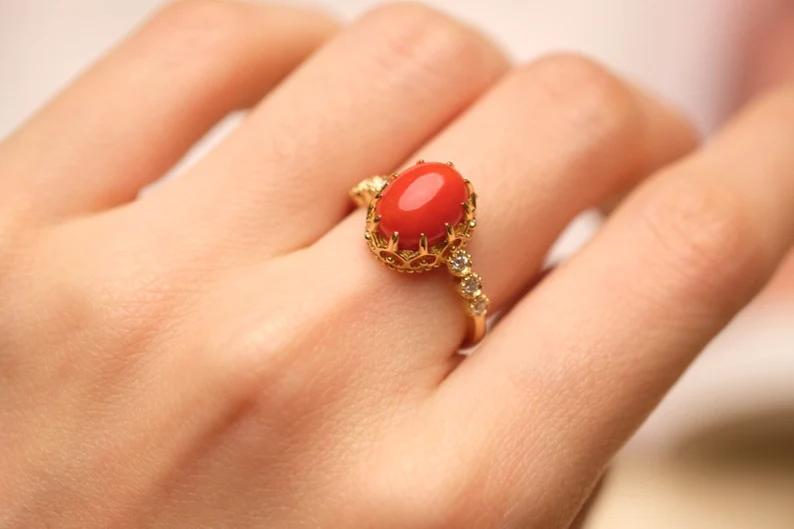Beneath the Waves: The Versatile Coral Stones
Coral stones have been used in jewellery for centuries due to their unique and striking appearance. These stones are made from the skeletons of marine animals called coral polyps, which grow in colonies in warm waters. Coral stones come in a variety of colours, including pink, red, white, and black. In this blog post, we will explore the history and significance of coral stones in jewellery, their properties, and their modern-day use.

History and Significance of Coral Stones in Jewellery
Coral has been used in jewellery for thousands of years, dating back to ancient civilizations such as the Greeks, Romans, and Egyptians. In ancient Egypt, coral was used in amulets and necklaces as a symbol of protection and life. The Greeks believed that coral had medicinal properties and used it to cure ailments such as stomach problems and headaches.
During the Renaissance period, coral became a popular material for jewellery in Italy. It was particularly popular in Naples, where coral fishing was a significant industry. Coral was often used to make intricate and elaborate pieces of jewellery, such as rosaries, pendants, and earrings.
In Victorian times, coral was considered a fashionable and elegant material for jewellery. Queen Victoria herself was a fan of coral jewellery and had a collection of coral necklaces, bracelets, and brooches. Coral was often paired with diamonds or pearls to create stunning and unique pieces.
Properties of Coral Stones
Coral stones are formed from the calcium carbonate skeletons of marine animals called coral polyps. They are typically found in warm waters, such as the Mediterranean Sea and the Red Sea. Coral stones come in a variety of colours, ranging from pale pink to deep red, and can also be white, black, or blue.
Coral is a relatively soft material, with a hardness rating of 3.5 to 4 on the Mohs scale. This means that it is more susceptible to scratches and damage than harder gemstones such as diamonds and sapphires. Coral is also porous, which means that it can be affected by chemicals, heat, and sunlight.
Modern-Day Use of Coral Stones
In modern times, coral is still a popular material for jewellery, particularly in the form of beads and cabochons. Coral beads are often used to make necklaces, bracelets, and earrings, and can be found in a variety of colours and sizes. Coral cabochons are used to make rings, pendants, and other statement pieces.
However, the use of coral in jewellery has become increasingly controversial in recent years due to the impact of coral harvesting on marine ecosystems. Coral harvesting can cause significant damage to coral reefs and marine life, and many conservation organisations are calling for a ban on coral harvesting and trade.
Coral Stones often go hand in hand with pearl stones because of their esteem compatibility.
As a result, many jewellery designers are now using alternative materials that mimic the appearance of coral, such as resin, plastic, and glass. These materials are more sustainable and eco-friendly than natural coral and can still create stunning and unique pieces of jewellery.
Wrapping Up
Coral stones have a rich history and significance in jewellery, dating back to ancient civilizations such as the Greeks, Romans, and Egyptians. While coral is still a popular material for jewellery today, its use has become increasingly controversial due to the impact of coral harvesting on marine ecosystems. As a result, many designers are now using alternative materials that mimic the appearance of coral, such as resin, plastic, and glass.
Related Questions:
Are coral stones expensive?
The cost of coral stones can vary depending on their quality, size, and colour. Natural coral is typically more expensive than synthetic or imitation coral.
How do I take care of coral jewellery?
Coral is a relatively soft and porous material, so it should be stored separately from other jewellery to avoid scratches and damage. Coral should also be protected from heat and sunlight, as these can cause discolouration and damage. To clean coral jewellery, use a soft brush and mild soap and water. Avoid using harsh chemicals or ultrasonic cleaners, as these can damage the coral. It is also important to avoid exposing coral jewellery to perfumes, lotions, and other chemicals, as these can be absorbed by the porous material and cause damage over time.
Is it ethical to use coral in jewellery?
The use of coral in jewellery has become increasingly controversial in recent years due to the impact of coral harvesting on marine ecosystems. Coral harvesting can cause significant damage to coral reefs and marine life, and many conservation organisations are calling for a ban on coral harvesting and trade. As a result, many jewellery designers are now using alternative materials that mimic the appearance of coral, such as resin, plastic, and glass.
What are some alternative materials that mimic the appearance of coral?
Some alternative materials that mimic the appearance of coral include resin, plastic, and glass. These materials are more sustainable and eco-friendly than natural coral and can still create stunning and unique pieces of jewellery.
What colours do coral stones come in?
Coral stones come in a variety of colours, including pink, red, white, and black. They can also be found in shades of orange, yellow, and blue. The colour of coral stones can be affected by a variety of factors, including the water temperature, the depth at which the coral was harvested, and the species of coral.
